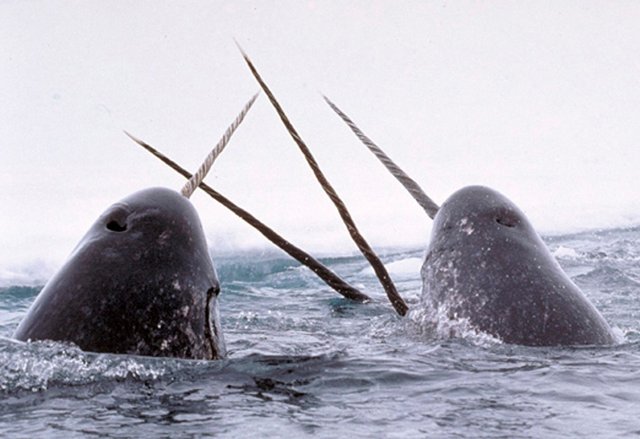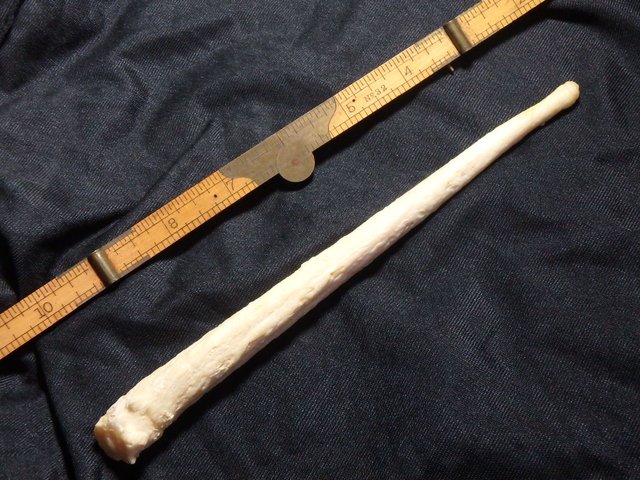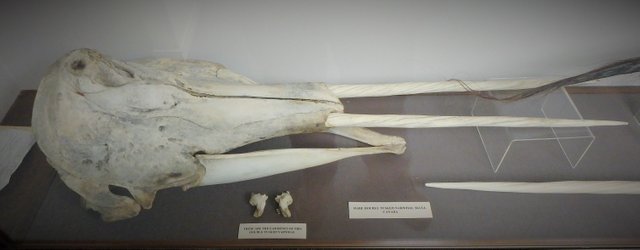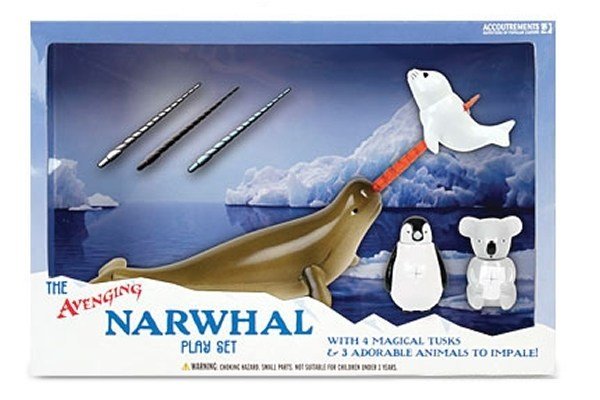The Narwhal's puzzling two front teeth

Source: animals.wiki.com
The Narwhal’s most obvious feature is the male’s marvelous spiralled tusk that juts out of the left side of its upper jaw. It’s variously described as a canine or incisor so, like other mammals, there should be a pair of them, right? Well, sure enough, there is another tooth! It’s on the other side of its jaw but like a wisdom tooth that hasn’t emerged yet, it’s buried inside its gums.
Some years back, I decided a 6-foot long narwhal tusk would make a great addition to my ‘Cabinet of Curiosities.’ My early searches quickly revealed that not only do prime examples cost more than $10,000 but one needs all kinds of permits to acquire and own one. Narwhal tusks are legislated under international ivory trade laws.
But then I stumbled across a smaller version, the aforementioned ‘missing tooth.’ It gets to be about 6-10 inches long and because it doesn’t emerge from the skin, it’s legally considered to be a tooth rather than a tusk. It is therefore, exempt from the ivory laws. The price was quite reasonable, too, something like $100 when I got it a few years back, so I ordered one.

In about one in 500 males, that little right tooth goes through a growth spurt and becomes a second tusk. Females occasionally get an emerging tusk as well but it’s a much smaller version. There are a number of other small vestigial teeth but when it opens its mouth, it looks basically toothless.

Skull of double-toothed Narwhal (Courtesy Stones & Bones Museum)
The world’s 75,000 narwhals inhabit northern waters with main populations concentrated in the eastern Canadian Arctic. They are migratory and follow their food sources of halibut, cod, shrimp, and squid. They can descend to depths of 5,000 feet in dives lasting 25 minutes. An adult male is generally about 12-15 feet long and weighs about 3000 pounds. A female weighs a third less. If they manage to escape marauding killer whales, Greenland sharks, polar bears, and hunters, they may live as long as 100 years.
Narwhals have been harvested for over a millennium by Inuits in northern Canada and Greenland. A highly regulated subsistence hunt continues today and is an important bonding experience for Inuit communities. All of the animal’s meat is used and the tusks are sold to generate some income.
Tusks can be exported from Canada to several countries but sorry, USA, you’re not one of them. American laws prohibit the trade in ivory and that includes narwhal tusks.
The tusks come out of the sea black with a clean white tip from use. The tusks are then bleached and cleaned to make them a bright white, then have mineral oil applied to prevent cracking.
Its scientific name is Monodon monoceros: one tooth, one horn. It’s this idea of the tusk as a horn that connects with early unicorn legends. Tusks found on the beaches of medieval Europe were believed to have been actual unicorn’s horns. Entrepreneurs travelled north to harvest the tusks and sold them for huge sums. Powders and products from unicorn horns were worth a fortune as the substance were believed to have magical powers. Cups made from unicorn ivory had the power to neutralize poisons slipped into drinks. The bottom fell out of the market when European naturalists discovered the true source of the horns.
The truth about the tusk is no less amazing or mysterious. As its mainly a male feature, it undoubtedly serves as a sexual characteristic of some sort and its length may indicate social rank. Size matters, apparently! (If a large tusk appeals to a female, I wonder how she would react to a double tusked male?)
One researcher who’s devoting a lot of time trying to unravel the mysterious purposes of the tusk is Dr. Martin Nweeia, who, appropriately enough, is a dentist! “What on Earth is this marine mammal doing with this mythical tusk?” he wonders. “There was nothing about the narwhal that made any sense to me. In fact, many of its features contradicted everything I had learned about teeth in dental school.”
Dr. Nweeia is fascinated by the fact that narwhals put all their tooth-growing energy into a single tusk rather than having a set of teeth to help them eat their diet of large fish, such as halibut. He’s discovered that the tusk is actually a super-sensitive rod. Unlike other mammalian teeth, this one has no enamel on its exterior. The tooth has a permeable membrane with a high quantity of tubules and nerve endings in the pulp. This leads Nweeia into thinking that it could be a highly sensitive sensory organ able to detect subtle changes in temperature, salinity, and pressure. This could assist in navigation or finding fish prey.
Narwhal males have been observed ‘sparring’ with their tusks. It has long been thought that this might be some form of territorial swordplay but Dr. Nweeia suggests they may actually be rubbing each other’s tusks in an effort to keep them clean! There is obviously much more to be discovered about the unusual tusk.

Avenging-Narwhal-Playset
In a somewhat bizarre afternote, I discovered a strange toy on-line (and immediately ordered one!). It’s the ‘Avenging Narwhal Playset.’ Inside the box comes a small rubbery narwhal with interchangeable tusks and three ‘adorable’ animals to impale! The toy’s story goes that the strange-looking narwhal was constantly teased in school by penguins. One day, the whale uncovers a penguin conspiracy to take over the world. “Penguins have employed a propaganda campaign of nature documentaries and animated films to cause people to become enamored with their clumsy gait, their monogamy, and darling survival mechanism of huddling their blubber-covered bodies together for warmth.”
“The Avenging Narwhal has since made it his duty to crush the penguins’ evil plot by piercing them in their cute bellies with his magical tusk, thereby reducing the number of waddling, formalwear-clad threats to humanity! “
This one was informative . I guess you ll enjoy you new toy..
thanks for reading!
That is an absolutely terrifying toy.
It makes you wonder about the person who invented it!
Haha you're right!
So if the tooth is a tuning fork and it has no teeth. Does it chew or just swallow it's prey?
Very interesting. Thanks for sharing. Joy
It sucks its food up and swallows whole, mostly softer things like fish and squid so it doesn't really need teeth!
Lol. Ok. Thanks. :)
This post has received a 25.00 % upvote from @moneymatchgaming thanks to: @cavesson. Upvote this Post to Support the MMG Community on Steemit! :)
You got a 1.99% upvote from @upmewhale courtesy of @cavesson!
You just rose by 1.6374% upvote from @therising courtesy of @cavesson. Earn 43.8% APR by delegating SP to therising. For more details visit: https://steemit.com/budget/@therising/auto-daily-payout-of-43-8-apr-for-steem-power-delegations-starting-from-500-sp-only-limited-period-offer.
You got a 2.56% upvote from @nado.bot courtesy of @cavesson!
Send at least 0.1 SBD to participate in bid and get upvote of 0%-100% with full voting power.